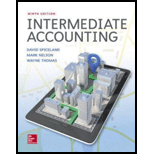
Concept explainers
Various inventory transactions;
• LO8–1 through LO8–3
James Company began the month of October with inventory of $15,000. The following inventory transactions occurred during the month:
a. The company purchased merchandise on account for $22,000 on October 12, 2018. Terms of the purchase were 2/10, n/30. James uses the net method to record purchases. The merchandise was shipped f.o.b. shipping point and freight charges of $500 were paid in cash.
b. On October 31, James paid for the merchandise purchased on October 12.
c. During October merchandise costing $18,000 was sold on account for $28,000.
d. It was determined that inventory on hand at the end of October cost $19,060.
Required:
1. Assuming that the James Company uses a periodic inventory system, prepare journal entries for the above transactions including the
2. Assuming that the James Company uses a perpetual inventory system, prepare journal entries for the above transactions.
1.
Periodic Inventory System: It is a system in which the inventory is updated in the accounting records on a periodic basis such as at the end of each month, quarter or year. In other words, it is an accounting method which is used to determine the amount of inventory at the end of each accounting period.
Perpetual Inventory System refers to the inventory system that maintains the detailed records of every inventory transactions related to purchases and sales on a continuous basis. It shows the exact on-hand-inventory at any point of time.
To Record: The journal entries using periodic inventory system.
Explanation of Solution
a. Record the entry for purchase on account.
| Date | Account Title and Explanation | Post Ref. |
Debit ($) |
Credit ($) |
| October 12, 2018 | Purchases | 21,560 (1) | ||
| Accounts Payable | 21,560 | |||
| (To record the purchase of inventories on account) |
Table (1)
Working Note:
Compute the purchase price of the inventory.
- Purchases account is an expense and it is decreased the equity value by $21,560. Therefore, debit purchase account with $21,560.
- Accounts payable is a liability and it is increased by $21,560. Therefore, credit accounts payable account with $21,560.
Record the freight paid.
| Date | Account Title and Explanation | Post Ref. |
Debit ($) |
Credit ($) |
| October 12, 2018 | Freight-in | 500 | ||
| Cash | 500 | |||
| (To record the freight cost) |
Table (2)
- Freight-in account is an expense and it is decreased the equity value by $500. Therefore, debit freight-in account with $500.
- Cash is an asset and it is decreased by $500. Therefore, credit cash account with $500.
b. Record the payment of accounts payable.
| Date | Account Title and Explanation | Post Ref. |
Debit ($) |
Credit ($) |
| October 31, 2018 | Accounts Payable | 21,560 (1) | ||
| Interest Expense | 440 (2) | |||
| Cash | 22,000 | |||
| (To record the payment made to the supplier) |
Table (3)
Working Note:
Compute the interest expense.
- Accounts payable is a liability and it is decreased by $21,560. Therefore, debit accounts payable account with $21,560.
- Interest expense account is an expense and it is decreased the equity value by $440. Therefore, debit interest expense account with $440.
- Cash is an asset and it is decreased by $22,000. Therefore, credit cash account with $22,000.
c. Record the sales entry.
| Date | Account Title and Explanation | Post Ref. |
Debit ($) |
Credit ($) |
| October 2018 | Accounts Receivable | 28,000 | ||
| Sales Revenue | 28,000 | |||
| (To record the sales on account) |
Table (4)
- Accounts receivable is an asset and it is increased by $28,000. Therefore, debit accounts receivable account with $28,000.
- Sales revenue is revenue and it increases the value of equity by $28,000. Therefore, credit sales revenue with $28,000.
Note:
There is no entry required for cost of goods sold under the periodic method.
d. Record the year-end adjusting entry.
| Date | Account Title and Explanation | Post Ref. |
Debit ($) |
Credit ($) |
| October 31, 2018 | Cost of Goods Sold (Refer Table 6) |
18,000 | ||
| Ending Inventory | 19,060 | |||
| Beginning Inventory | 15,000 | |||
| Purchases | 21,560 | |||
| Freight-in | 500 | |||
| (To record the cost of goods sold) |
Table (5)
Working Note:
Calculate the cost of goods sold.
| Particulars | Amount ($) | Amount ($) |
| Beginning Inventory | 15,000 | |
| Add: Net Purchases | ||
| Purchases | 21,560 | |
| Freight-in | 500 | 22,060 |
| Cost of goods available for sale | 37,060 | |
| Less: Ending Inventory | (19,060) | |
| Cost Of Goods Sold | 18,000 |
Table (6)
- Cost of Goods Sold and Ending Inventory generally shows a credit balance. Therefore, to close these accounts, it should be debited. Therefore, debit all the above mentioned accounts with their respective amounts.
- Beginning Inventory, Purchases, and Freight-In generally shows a debit balance. Therefore, to close these accounts, it should be credited. Therefore, credit all the above mentioned accounts with their respective amounts.
2.
To Record: The journal entries using perpetual inventory system.
Explanation of Solution
a. Record the entry for purchase on account.
| Date | Account Title and Explanation | Post Ref. |
Debit ($) |
Credit ($) |
| October 12, 2018 | Inventory | 21,560 | ||
| Accounts Payable | 21,560 | |||
| (To record the purchase of inventories on account) |
Table (7)
- Inventory is an asset and it is increased by $21,560. Therefore, debit inventory account with $21,560.
- Accounts payable is a liability and it is increased by $21,560. Therefore, credit accounts payable account with $21,560.
Record the freight paid.
| Date | Account Title and Explanation | Post Ref. |
Debit ($) |
Credit ($) |
| Inventory | 500 | |||
| Cash | 500 | |||
| (To record the freight cost) |
Table (8)
- Inventory is an asset and it is increased by $500. Therefore, debit inventory account with $500.
- Cash is an asset and it is decreased by $500. Therefore, credit cash account with $500.
b. Record the payment of accounts payable.
| Date | Account Title and Explanation | Post Ref. |
Debit ($) |
Credit ($) |
| October 31, 2018 | Accounts Payable | 21,560 (1) | ||
| Interest Expense | 440(2) | |||
| Cash | 22,000 | |||
| (To record the payment made to the supplier) |
Table (9)
- Accounts payable is a liability and it is decreased by $21,560. Therefore, debit accounts payable account with $21,560.
- Interest expense account is an expense and it is decreased the equity value by $440. Therefore, debit interest expense account with $440.
- Cash is an asset and it is decreased by $22,000. Therefore, credit cash account with $22,000.
c. Record the sales entry.
| Date | Account Title and Explanation | Post Ref. |
Debit ($) |
Credit ($) |
| October 2018 | Accounts Receivable | 28,000 | ||
| Sales Revenue | 28,000 | |||
| (To record the sales on account) |
Table (10)
- Accounts receivable is an asset and it is increased by $28,000. Therefore, debit accounts receivable account with $28,000.
- Sales revenue is revenue and it increases the value of equity by $28,000. Therefore, credit sales revenue with $28,000.
The following is the journal entry.
| Date | Account Title and Explanation | Post Ref. |
Debit ($) |
Credit ($) |
| October 2018 | Cost of Goods Sold | 18,000 | ||
| Merchandised Inventory | 18,000 | |||
| (To record the cost of goods sold) |
Table (11)
- Cost of goods sold is an expense account and it decreases the value of equity by $18,000. Therefore, debit cost of goods sold account with $18,000.
- Inventory is an asset and it is decreased by $18,000. Therefore, credit inventory account with $18,000.
d. Record the year-end adjusting entry.
Note:
No entry required for the year-end adjusting entry under perpetual inventory system.
Want to see more full solutions like this?
Chapter 8 Solutions
Intermediate Accounting
- Please provide the correct answer to this general accounting problem using accurate calculations.arrow_forwardI need help with this financial accounting question using standard accounting techniques.arrow_forwardI need help with this general accounting question using standard accounting techniques.arrow_forward
- I am trying to find the accurate solution to this financial accounting problem with the correct explanation.arrow_forwardPlease help me solve this financial accounting question using the right financial principles.arrow_forwardPlease explain the solution to this financial accounting problem with accurate explanations.arrow_forward
- Please explain the correct approach for solving this financial accounting question.arrow_forwardPlease provide the answer to this financial accounting question with proper steps.arrow_forwardI am searching for the correct answer to this financial accounting problem with proper accounting rules.arrow_forward
- I need help finding the accurate solution to this financial accounting problem with valid methods.arrow_forwardI am looking for help with this general accounting question using proper accounting standards.arrow_forwardCan you explain this financial accounting question using accurate calculation methods?arrow_forward
 Intermediate Accounting: Reporting And AnalysisAccountingISBN:9781337788281Author:James M. Wahlen, Jefferson P. Jones, Donald PagachPublisher:Cengage Learning
Intermediate Accounting: Reporting And AnalysisAccountingISBN:9781337788281Author:James M. Wahlen, Jefferson P. Jones, Donald PagachPublisher:Cengage Learning Cornerstones of Financial AccountingAccountingISBN:9781337690881Author:Jay Rich, Jeff JonesPublisher:Cengage Learning
Cornerstones of Financial AccountingAccountingISBN:9781337690881Author:Jay Rich, Jeff JonesPublisher:Cengage Learning Financial And Managerial AccountingAccountingISBN:9781337902663Author:WARREN, Carl S.Publisher:Cengage Learning,
Financial And Managerial AccountingAccountingISBN:9781337902663Author:WARREN, Carl S.Publisher:Cengage Learning,- Principles of Accounting Volume 1AccountingISBN:9781947172685Author:OpenStaxPublisher:OpenStax College
 College Accounting, Chapters 1-27 (New in Account...AccountingISBN:9781305666160Author:James A. Heintz, Robert W. ParryPublisher:Cengage Learning
College Accounting, Chapters 1-27 (New in Account...AccountingISBN:9781305666160Author:James A. Heintz, Robert W. ParryPublisher:Cengage Learning Financial Accounting: The Impact on Decision Make...AccountingISBN:9781305654174Author:Gary A. Porter, Curtis L. NortonPublisher:Cengage Learning
Financial Accounting: The Impact on Decision Make...AccountingISBN:9781305654174Author:Gary A. Porter, Curtis L. NortonPublisher:Cengage Learning





